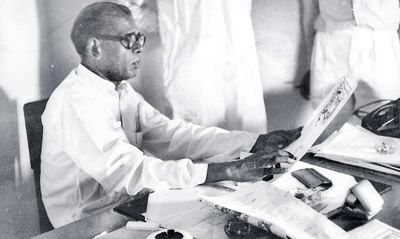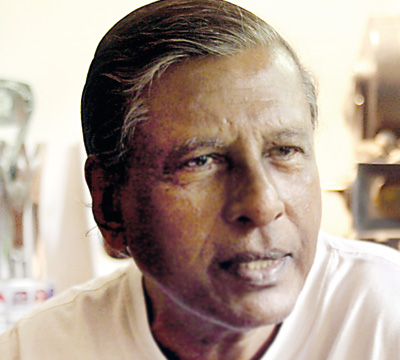His pen might as well have been a scalpel. With a few well chosen words, D.B. Dhanapala could slice past pretence and posturing to lay his subject bare before you. He chose to write about prominent Sri Lankans who had been scholars, journalists, healers,artists and diplomats, but politicians were perhaps his favourite fodder of all.
So it is that he describes Arunachalam Mahadeva, one time Minister of Home Affairs, as both a “well-bred gentleman” and a “tragedy in a turban.” He praises Prime Minister Dudley Senanyake’s thoughtfulness but then gently condemns his lack of boldness. Of Prime Minister John Kotelawala he notes: “He was not afraid to say anything. But what he was not afraid to say was often the wrong thing.”
This month marks the much awaited re-release of ‘Among Those Present’, a series of pen portraits by an iconic Sri Lankan journalist. Included in the set of over 20 articles are ones on the likes of Anagarika Dharmapala, Don Stephen and Dudley Senanayake, Ediriweera Sarathchandra, G.P Malasekera, Nicholas Attygalle, Senarat Paranavithana and Yakkaduve Thero.
Remembered as the man who wrote for the ‘Ceylon Daily News’ under the pseudonym ‘Janus,’ their author’s legacy endures most notably in a thriving Sinhala press. As the editor in chief of the ‘Lankadeepa’, Dhanapala is credited with the creation of the first Sinhala daily that was not a mere translation of an English paper but produced its own original content.
He also re-imagined staid layout, working in cartoons and film pages and even encouraging the use of by-lines for his journalists. However, it was writing as Janus that he gained a cult like status. That Dhanapala had only begun learning the English alphabet as a 14-year-old but had progressed rapidly enough to conquer a Master’s Degree in English Literature by the time he was 26, only made his accomplishments all the more extraordinary.
 |
| D.B. Dhanapala at work (above) and his son D.B. Nihalsingha (below) |
 |
Forty years after his father’s passing, the award-winning filmmaker, Dr. D.B. Nihalsingha says he undertook to publish the book in response to the continued interest in it. “The only copies that still existed had fallen to pieces, having been passed from hand to hand,” he says.
“Those who had heard about it, wanted to read it. Those who had read it, wanted to re-read it.” Everyone called his father Janus, he says, remembering that as a journalist who was a regular visitor to Temple Trees and one who routinely hobnobbed with the greatest in the land, Dhanapala never lost sight of his calling.
“He knew these people very well,” Dr. Nihalsingha says, “they were all his buddies.” Amazingly, they stayed that way even after Janus revealed things about them that had previously been well kept secrets. “He was always very cordial, but also very frank.”
“His was a long walk from the backyards of Tissamaharamaya to the bastions of the Brown Sahibs in Colombo via Allahabad University in India,” writes Amara Hewamaduama, Former Secretary of the Ministry of Religious and Cultural Affairs in the introduction to Dhanapala that prefaces the collection of portraits. He goes on to praise the man for changing the “scope of the Press from being guardians of rulers to one where mass media stimulated and awakened national sentiment.”
It was clear that Dhanapala lived in tumultuous times – “The people he was writing about shaped Sri Lanka into what it is today,” says Dr. Nihalsingha, adding “He was an extraordinary man, surrounded by other extraordinary people.” When Janus first appeared on the Blue Page in the Ceylon Daily News it was 1937. By the time ‘Among Those Present’ had been published in 1963, Ceylon had become independent, S. W. R. D. Bandaranaike had introduced the controversial Sinhala Only Act and when he was assassinated, his widow became the world’s first female head of state.
Dhanapala, who had begun by championing S. W. R. D was often disappointed by his day to day politics. Dr. Nihalsingha remembers the Prime Minister calling to ask his father why he was being attacked so strongly in the press, to which Dhanapala responded frankly that the Prime Minister had not stood by his promises. After S. W. R. D’s assassination, Dhanapala wrote of his widow’s ascension, describing Sirimavo as “Intellectually like a rapier; emotionally, like a pair of scales.”
A reader cannot help but note that Dhanapala skims over the terrible controversy of the Sinhala Only Act and speaks of Sirimavo with nothing but appreciation. But with the essays belonging to the years between 1936 and 1960, Dr. Nihalsingha emphasises that they must be read now in that context.
Today, Dr. Nihalsingha remembers his father as a sociable man who would often bring 10 or 15 people home to his unsuspecting wife Rathni, asking her to rustle up something for their guests on the spur of the moment. (It was the meeting between his parents at Tagore’s Shantiniketan, where Rathni was perhaps the great man’s last Sri Lankan pupil, that likely inspired Dhanapala to begin his study of Sri Lankan painting and sculpture, says Dr. Nihalsingha, adding that his father would eventually become an authority in the field.)
So well connected, and always in the know, Dhanapala’s incisive intellect and disarming candour would win him many admirers. “To the country he gave a style and vision of what the duty of a journalist should be,” says Dr. Nihalsingha, explaining that even where his father’s name is forgotten, the spirit he embodies “endures to this day.”
Details about the book
The second edition of ‘Among Those Present’ is priced at Rs. 350 and is available at Vijitha Yapa Bookstores, LakeHouse and Sarasavi bookstores. Free delivery in the Colombo area on a cash on receipt basis can be had by calling 0770487878.
Excerpt from ‘Among Those Present’ and the chapter
on S.W.R.D Bandaranaike
Twenty-Five years ago I described Solomon West Ridgeway Dias Bandaranaike as a man with a future behind him.
It was a time when in that Mecca of mediocrities called the State Council of Ceylon he stood out as an infidel with cleverness as his creed and smartness as the manner of his mind.
He had what is called ‘background.’ That in itself was not anything unique. Many of those in the State Council could with an engaging gesture, point in a leisurely way towards some kind of estimable association, family prestige and good education. But Bandaranaike combined ‘background’ with brilliance; a familiar name with unfamiliar talent.
He certainly was one of the three best speakers we had then in Ceylon. Never at a loss for a word, with fluency and a diction that even Radhakrishnan might envy, he would reel off one perfect sentence after another with an astounding ease that baffled slow-witted men like me.
When he rose of an evening, especially immediately after one of our fathers of repetition, his speeches shone like burnished gold in the sunlight.
For a moment or two he would play, with velvet pawed syllables, with his opponent -he might even throw the sop of a left-handed compliment.
Then he seemed to roll up his sleeves and get down to business. He hurled choice epithets at the subject. He stabbed the foe with jewelled phrases, made on the spur of the moment - but made to hurt, all the same.
He would pat a favourite - or better perhaps himself - on the back. And then he rode away in a storm of oratory, all spontaneity and splendour with the distant thud of his galloping prose resounding in our ears.
It was neither lightning nor thunder; nor was it an earthquake. It was just the Member for Veyangoda.
But his speeches were not faultless. He had the heavy habit of talking in italics - at the top of his voice. And he underlined almost every other word of the italics with an absolutely unnecessary emphasis. The effect of stressing too much was not stressing anything at all!
With this distressing disease of underlining his megaphone voice, he combines an irritating appreciation of himself at every turn of phrase and parenthesis. Maybe, he paused for just a moment; looked round for applause; then, finding not enough forthcoming, remedied the defect himself by giving a little chuckle of appreciation - something between the clucking of a hen after laying and the laugh of a juggler on doing a celebrated trick.
He talked in jeweled prose well enunciated. But the magic was entirely in the fine phrasing; the appeal, in the strong epithet.
He knew how to say it. If only he had known then what to say!
Not that there were no occasions when he did know to a point of cruelty the right thing to utter. Hurt his vanity and he starts to the quick. Give him a personal pinprick to see how quick he was on the uptake. Pat comes the retort, crushing in vengeance, killing in venom.
He was the master of the retort discourteous, the apostle of the sharp invective in the country.
|



